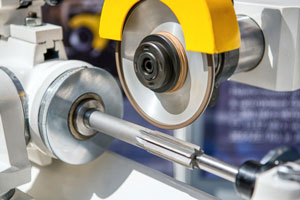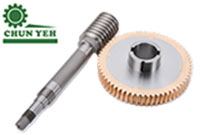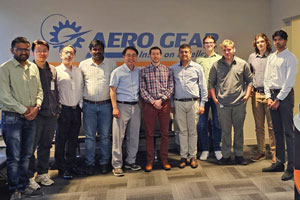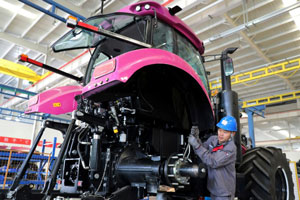
[please visit our sponsor]


Fundamentals of Gear Design and Analysis
June 25–27—Embassy Suites O’Hare; Rosemont, IL
Gain a solid and fundamental understanding of gear geometry, types and arrangements, and basic design principles. Starting with the basic definitions of gears, conjugate motion, and the Laws of Gearing, learn the tools needed to understand the inter-relation and coordinated motion operating within gear pairs and multi-gear trains. Basic gear system design process, gear measurement, and inspection techniques will also be explained.Register Today
Advanced Concepts of Bearing Technology
June 24–27—Embassy Suites O’Hare; Rosemont, IL
This course builds on the foundations of the essential course and challenges the experienced engineer in areas such as failure modes, friction & wear, fatigue life calculation methods and load distribution. This is an exceptional course for engineers with 2-3 years work experience in bearings or past attendees of the Essential Concepts of Bearing Technology.Register Today

Operator Precision Gear Grinding
Live Online Virtual Training | July 24-25
Explore precision gear grinding processes, machine input variables, kinematics, machine alignment, setup errors, pitfalls, common gear fatigue failures and expectations related to finish ground gearing. Learn definitions of gearing component features, application loads and process steps from blanking, through heat treatment to finished part ready to ship. Study aspects of Quality Assurance, Inspection Documentation and corrective actions for measured non-conformances. Understand pre-heat treat, heat treatment distortion and post heat treatment operations including the how's and why's to produce finished gears that conform and perform to end user expectations. Calculate gear form grinding cycle times for real life examples for various accuracy levels on commercially available software.Register Today
Essentials Concepts of Bearing Technology
August 6-8, 2024 | Cleveland, OH
This course will give you an overview of the bearing industry as well as basic bearing types and applications. Knowledge of the key players, bearing types and terminology will ensure that everyone has a basic knowledge of the industry upon arrival. This course is specially designed for engineers and others with technical backgrounds that have limited exposure to bearings and need to adapt their technical training to bearings or seek an upgrade to their technical knowledge. The Essentials Course focuses on understanding basic tribology, bearing attributes and applications and explores the basic concepts around manufacturing methods, loads, lubrication and failure.Register Today
[please visit our sponsor]


Smart Move: Save Big with a CNC Recontrol
It’s hard to stay competitive with older gear machines using outdated controls. New machines are often too costly a solution – and you’ll wait months for delivery. The smart move is an MTB Recontrol. In just three months, and for a relative fraction of a new machine investment, we can recontrol most CNC gear machines – and bring them up to profitable new performance levels.
Learn more. Download the Whitepaper

4D High Pressure Gas Quenching vs. Press Quenching
SECO/VACUUM’s 4D High Pressure Gas Quench (HPGQ) offers superior distortion control compared to press quenching. Both processes quench one part at a time, but the 4D HPGQ process avoids inconsistencies of liquid press quenching. With 4D HPGQ, every part is heated and quenched identically, maximizing precision and minimizing secondary machining.
Read the Technical Paper

Unlocking infinite possibilities through efficient transmission with WORM drives
WORM drives enable precise motion, excel in tight spaces, and meet high torque demands in robotics, conveyors, and automotive sectors.
As industries evolve, they stand as enablers of progress, unlocking infinite potential with reliability.
CHUN YEH GEAR can manufacture - Max. Module: M10, Accuracy Capability: DIN 1, AGMA 14, JIS 0.
Read More
Automation Nation
Power Transmission Engineering
Almost 43,000 registrants came together in Chicago to seek out the latest and greatest automation and robotic technologies during Automate 2024 in May. As always, A3 did not disappoint with a comprehensive conference paired with new automation technologies on the exhibition floor.Read More
Avoiding Failure and Downtime: Imperatives to Specify Gear Drives
Power Transmission Engineering
Gear drives are fundamental in most processing operations, connecting the prime mover to the driven equipment and ensuring that the system has enough torque to effectively move product. Correctly specifying and selecting the proper gear drives for critical applications leads to reliability, greater uptime, and profitability.Read More
US Factory Activity, Construction Spending Both Fall
Reuters
U.S. manufacturing activity slowed for a second straight month in May as new goods orders dropped by the most in nearly two years, and spending on construction projects slipped unexpectedly the month before, the latest indications that a gradual slowdown in the economy is taking hold.Read More
 |  |
Aero Gear Hosts UConn Students
UConn Today
Faculty, staff, and students from UConn's Connecticut Manufacturing Simulation Center (CMSC) visited engineers at Aero Gear, Inc. on May 29 to provide UConn students with an opportunity to observe various manufacturing processes at the company. CMSC offers small Connecticut manufacturing businesses with free technical support and specialized machining processes and simulations.Read More
How manufacturers are reskilling factory workers for AI adoption
ManufacturingDive
Companies are leveraging the metaverse and augmented reality to train workers to use artificial intelligence for assembly and maintenance tasks.Read More
The Future of Additive Manufacturing
SME
Additive manufacturing (AM) will develop on multiple paths in coming years. It will penetrate new and existing markets, such as aerospace, automotive, healthcare, energy and consumer products. Asia will play an increasingly important role, both in the development and adoption of AM. As the technology grows in popularity, we will see an increase in the significance of industry standards, safety and requirements associated with qualification, certification and regulations. Meanwhile, applications, materials and special solutions to new opportunities will drive AM to a much higher level of maturity.Read More
 |  |
Manufacturing Executives Confident But Careful Heading Into Summer
IndustryWeek
In February and March, the country’s largest manufacturing companies believed (maybe hoped?) that the second half of 2024 would bring healthier and more balanced growth. Three months later, that belief is maturing into a confidence about what’s ahead this summer and fall.Read More
Steps for Creating a Positive Workplace Culture in Manufacturing
Digital Journal
Businesses in the manufacturing sector should take a more empathetic approach to employee wellbeing and culture, according to an industry insider.Read More
AI Is Making Economists Rethink the Story of Automation
Harvard Business Review
Will artificial intelligence take our jobs? As AI raises new fears about a jobless future, it’s helpful to consider how economists’ understanding of technology and labor has evolved. For decades, economists were relatively optimistic, and pointed out that previous waves of technology had not led to mass unemployment. But as income inequality rose in much of the world, they began to revise their theories. Newer models of technology’s affects on the labor market account for the fact that it absolutely can displace workers and lower wages. In the long run, technology does tend to raise living standards. But how soon and how broadly? That depends on two factors: Whether technologies create new jobs for people to do and whether workers have a voice in technology’s deployment.Read More
 |  |


